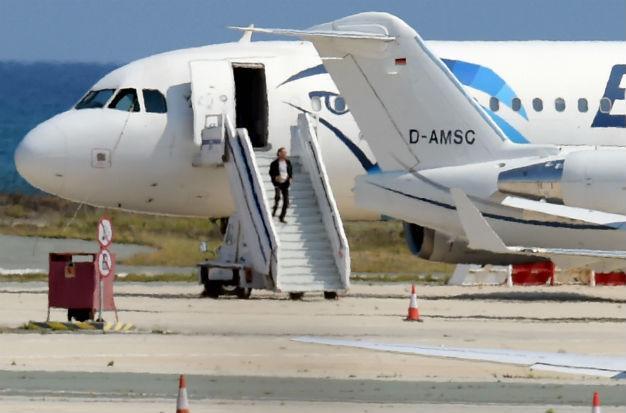Unusual plane hijackings since 2001
LARNACA - Agence France-Presse

AFP photo
Airplane hijackings such as the one that unfolded on March 29 involving an Egyptian airliner have become relatively rare since the September 11, 2001 terror attacks led to increased security.
The hijackings have been carried out mostly by individuals trying to resolve personal issues, and almost all ended swiftly and safely.
Here are some examples:
February 17, 2014: An Ethiopian Airlines flight to Rome with 202 people on board is diverted by its unarmed copilot to Geneva where he asks for asylum. Hailemedehin Abera Tagegn is arrested, but Switzerland refuses an Ethiopian request for his extradition.
February 7, 2014: A reportedly drunk Ukrainian hijacks a Pegasus Airlines flight with 110 people on board from Kharkov to Istanbul's Sabiha Gökçen airport, brandishing what he claims is a detonator and shouting "Let's go to Sochi," Russia, where the Winter Olympics opening ceremony is under way. The plane is escorted by Turkish F-16 jets to Istanbul where anti-terrorist commandos launch an assault that ends without any casualties.
September 10, 2009: A Bolivian preacher and former drug addict hijacks an Aeromexico airliner flying from Cancun to Mexico City with 104 people on board, saying he is on a divine mission. Presenting sand-filled juice cans with coloured lights as a bomb, Jose Marc Flores Pereira surrenders after the plane lands, with most passengers unaware they had been taken hostage. Pereira says he had to warn Mexico it was threatened by an earthquake.
August 26, 2008: Sun Air flight 611 carrying 95 people from Nyala to Khartoum is hijacked by two men and lands in Kufra, southern Libya after running low on fuel. The men surrender and all the passengers are freed, almost 24 hours later.
August 18, 2007: An Egyptian and a Turk who claim to be Al-Qaeda members hijack an Istanbul-bound Atlas Jet flight from the breakaway Turkish Republic of Northern Cyprus with more than 140 people on board and demand to fly to Iran or Syria. The pilots land in Antalya, Turkey to refuel, and while women and children are being freed by the front door, most of the other passengers escape through the rear. The rest are released several hours later when the two hijackers surrender.
October 3, 2006: An unarmed Turkish army deserter, Hakan Ekinci, seizes a Turkish Airways flight carrying 113 people from Tirana to Istanbul. The plane is forced by Greek and Italian jets to land in Brindisi, Italy. Ekinci had forced his way into the cockpit with a parcel that he said was a bomb, and told the pilot that he had a message for Pope Benedict XVI. He claimed to be a Christian convert and a conscientious objector, and sought help to avoid Turkey's compulsory military service.
September 12, 2005: A man in a wheelchair and his son hijack an Aires turbo-prop plane with 25 people onboard as it flies from Florencia to Neiva, and force the plane to land in Bogota before surrendering to authorities. Passengers say the men claimed to have grenades. They had demanded compensation for a police search of their home 14 years earlier, in which the father was wounded and crippled.
March 19, 2003: Six hijackers armed with a knife seize an old DC-3 airliner flying from Cuba's Isle of Youth to Havana with 35 people on board, and force it to divert to Florida, where it lands in Key West escorted by F-15 fighter jets in what the FBI describes as a "peaceful surrender".
February 20, 2002: Rebels from the Revolutionary Armed Forces of Colombia (FARC) hijack a plane bound for Bogota and force it to land on a highway in southern Colombia, kidnapping one of the 37 passengers, senator Jorge Gechem. He is held for more than six years and released on February 27, 2008.
